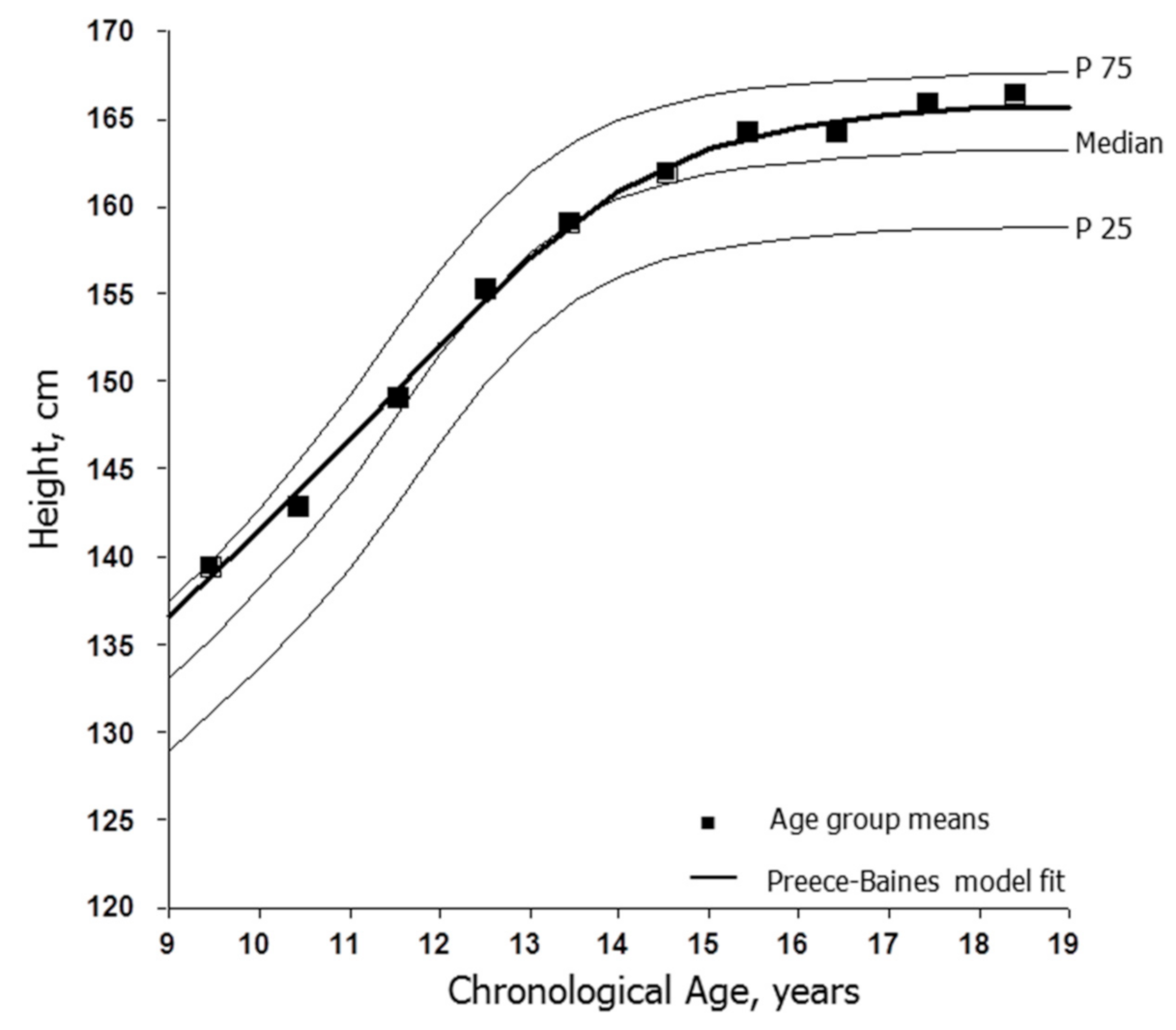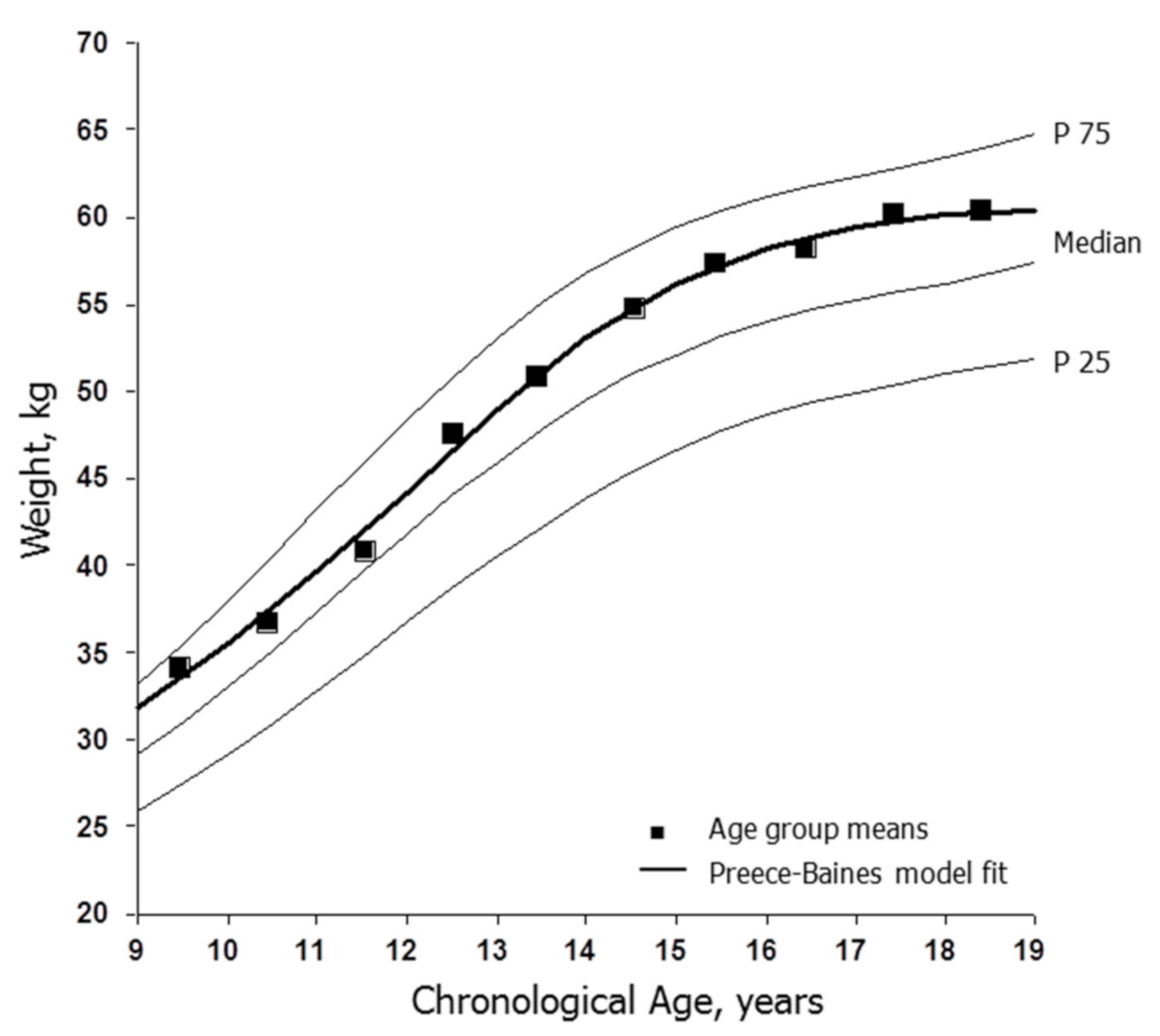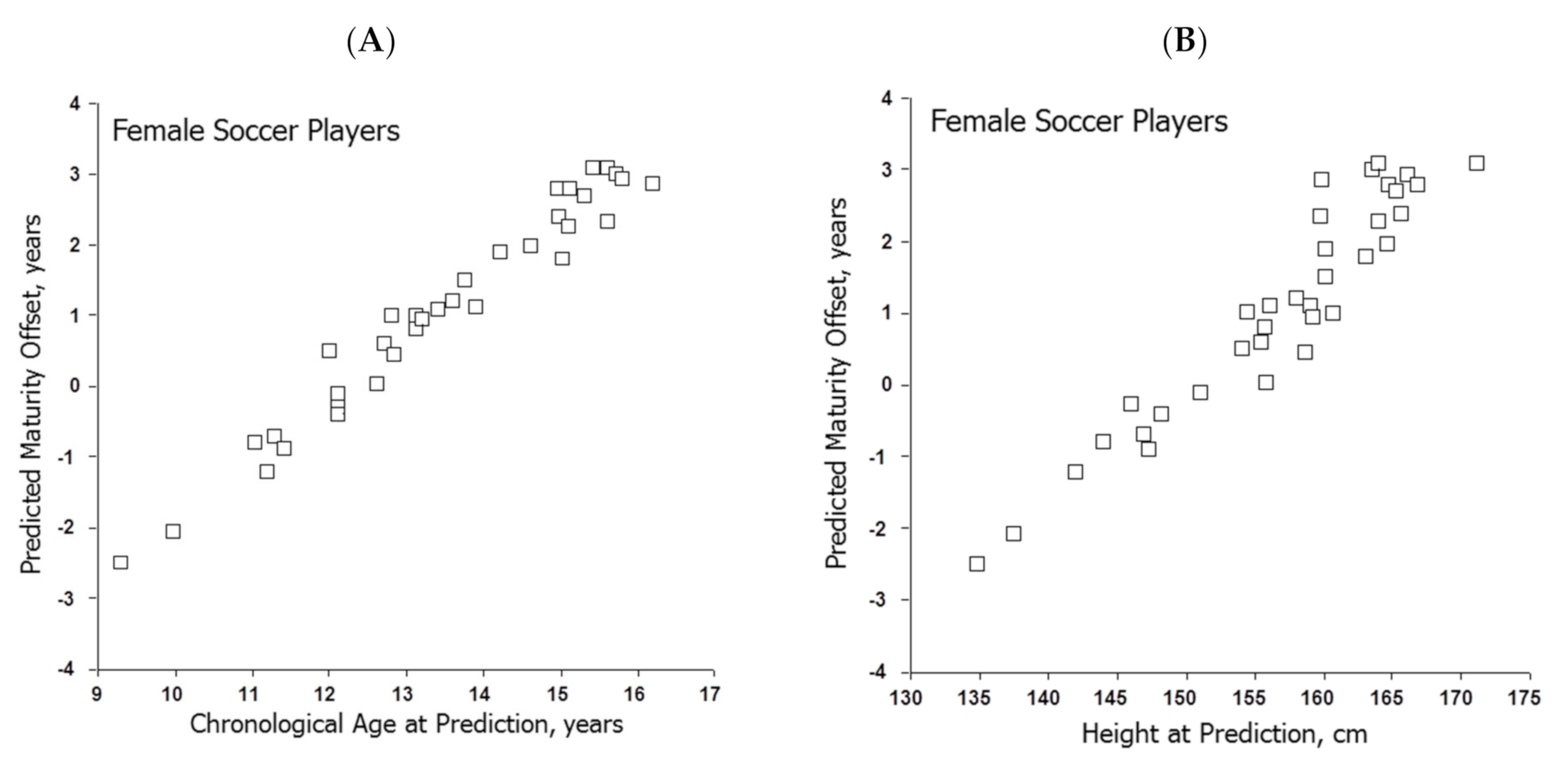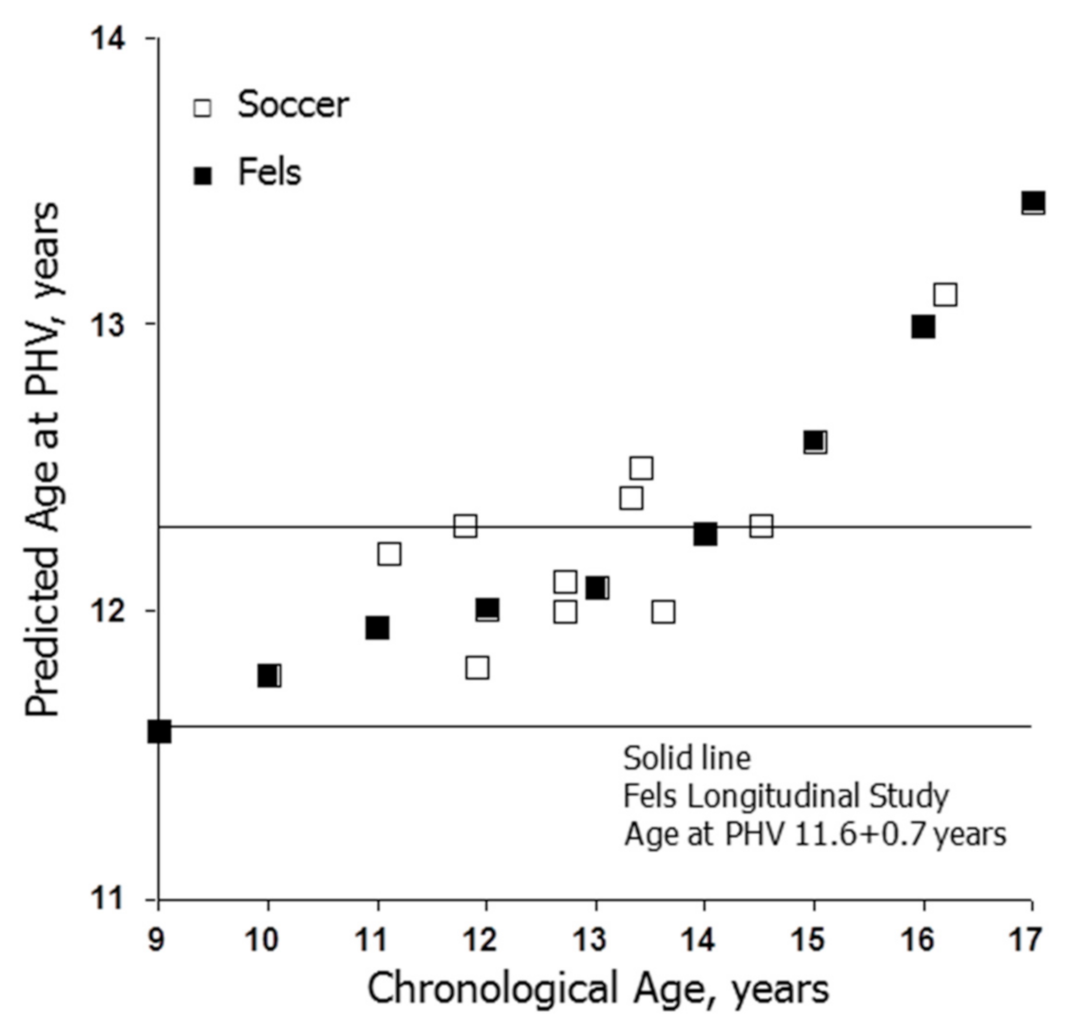Growth and Maturity Status of Female Soccer Players: A Narrative Review
Abstract
1. Introduction
2. Materials and Methods
2.1. Search Methods
2.2. Age, Height and Weight
2.3. Maturation
3. Results
3.1. Height and Weight
3.2. Maturity Status
3.2.1. Skeletal Age (SA)
3.2.2. Pubertal Status
3.2.3. Age at Menarche
3.2.4. Percentage of Predicted Adult Height
3.2.5. Predicted Maturity Offset/Age at PHV
4. Discussion
4.1. Height and Weight
4.2. Skeletal Maturation
4.3. Pubertal Status
4.4. Age at Menarche
4.5. Percentage of Predicted Adult Height
4.6. Predicted Maturity Offset
5. Summary
6. Implications
“Optimal aerobic training begins with the onset of Peak Height Velocity (PHV), more commonly known as the adolescent growth spurt. Strength training has two windows of accelerated adaptation in this phase. Window 1 is immediately after PHV and window 2 begins with the onset of menarche.”
Supplementary Materials
Author Contributions
Funding
Institutional Review Board Statement
Informed Consent Statement
Data Availability Statement
Acknowledgments
Conflicts of Interest
References
- Malina, R.M. Physical growth and biological maturation of young athletes. Exerc. Sports Sci. Rev. 1994, 22, 389–433. [Google Scholar] [CrossRef]
- Novotny, V. Veranderungen des Knochenalters im Verlauf einer mehrjahrigen sportlichen Belastung. Med. Sport 1981, 21, 44–47. [Google Scholar]
- Liu, N.Y.-S.; Plowman, S.A.; Wells, C.L. Somatotypes of premenarcheal athletes and non-athletes. Hum. Biol. 1989, 61, 227–247. [Google Scholar] [PubMed]
- National Federation of State High School Associations. High School Athletics Participation Statistics. Available online: www.nfhs.org (accessed on 9 September 2019).
- U.S. Youth Soccer. Key Statistics U.S. Youth Soccer. Membership Statistics. Available online: http://www.usyouthsoccer.org/media_kit/keystatistics/ (accessed on 12 August 2014).
- UEFA. Women’s Football across the National Associations; UEFA: Nyon, Switzerland, 2017. [Google Scholar]
- Nilsson, S.; Roaas, A. Soccer injuries in adolescents. Am. J. Sports Med. 1978, 6, 358–361. [Google Scholar] [CrossRef]
- Schmidt-Olsen, S.; Bünemann, L.K.H.; Lade, V.; Brassøe, J.O.K. Soccer injuries of youth. Br. J. Sports Med. 1985, 19, 161–164. [Google Scholar] [CrossRef]
- Andreasson, I.; Faunø, P.; Lund, B.; Lemche, P.; Knudsen, H. Soccer injuries among youth. Scan. J. Med. Sci. Sports 1992, 3, 62–66. [Google Scholar] [CrossRef]
- Kibler, W.B. Injuries in adolescent and preadolescent soccer players. Med. Sci. Sports Exerc. 1993, 25, 1330–1332. [Google Scholar] [CrossRef] [PubMed]
- Davis, J.A.; Brewer, J. Applied physiology of female soccer players. Sports Med. 1993, 16, 180–189. [Google Scholar] [CrossRef] [PubMed]
- Datson, N.; Hulton, A.; Andersson, H.; Lewis, T.; Weston, M.; Drust, B.; Gregson, W. Applied physiology of female soccer: An update. Sports Med. 2014, 44, 1225–1240. [Google Scholar] [CrossRef]
- Martínez-Lagunas, V.; Niessen, M.; Hartmann, U. Women’s football: Player characteristics and demands of the game. J. Sport Health Sci. 2014, 3, 258–272. [Google Scholar] [CrossRef]
- Pardos-Mainer, E.; Casajus, J.A.; Julian, C.; Bishop, C.; Gonzalo-Skok, O. Determining the reliability and usability of change of direction speed tests in adolescent female soccer players: A systematic review. J. Sports Med. Phys. Fit. 2020, 60, 720–732. [Google Scholar] [CrossRef] [PubMed]
- The Football Association. Long Term Player Development: Women’s and Girls’ Football—An Introductory Guide; The Football Association: London, UK; Available online: www.thefa.com (accessed on 23 November 2020).
- Hägglund, M.; Walden, M. Risk factors for acute knee injury in female youth football. Knee Surg. Sports Traumatol. Arthrosc. 2016, 24, 737–746. [Google Scholar] [CrossRef]
- Kuczmarski, R.J.; Ogden, C.L.; Grummer-Strawn, L.M.; Flegal, K.M.; Guo, S.S.; Wei, R.; Mei, Z.; Curtin, L.R.; Roche, A.F.; Johnson, C.L. CDC Growth Charts: United States. Advance Data from Vital and Health Statistics; No. 314; National Center for Health Statistics: Hyattsville, MD, USA, 2000.
- Roche, A.F. Postnatal physical growth assessment. Clin. Pediat. Endoc. 1999, 8 (Suppl. 12), 1–12. [Google Scholar]
- McDowell, M.A.; Fryar, C.D.; Ogden, C.L.; Flegal, K.M. Anthropometric Reference Data for Children and Adults: United States, 2003–2006; National Health Statistics Reports, No. 10; National Center for Health Statistics: Hyattsville, MD, USA, 2008.
- Fryar, C.D.; Gu, Q.; Ogden, C.L. Anthropometric Reference Data for Children and Adults: United States, 2007–2010. Vital and Health Statistics; Series 11; No. 252; National Center for Health Statistics: Hyattsville, MD, USA, 2012.
- Fryar, C.D.; Gu, Q.; Ogden, C.L.; Flegal, K.M. Anthropometric Reference Data for Children and Adults: United States, 2011–2014. Vital and Health Statistics; Series 3; No. 39; National Center for Health Statistics: Hyattsville, MD, USA, 2016.
- Kirkland, A.; O’Sullivan, M. There is no such thing as an international elite Under-9 soccer player. J. Sports Sci. Med. 2018, 17, 686–688. [Google Scholar] [PubMed]
- Preece, M.A.; Baines, M.J. A new family of mathematical models describing the human growth curve. Ann. Hum. Biol. 1978, 5, 1–24. [Google Scholar] [CrossRef] [PubMed]
- Hauspie, R.C.; Roelarts, M. Adolescent growth. In Human Growth and Development, 2nd ed.; Cameron, N., Bogin, B., Eds.; Elsevier: New York, NY, USA, 2012; pp. 57–79. [Google Scholar]
- Dell, Inc. Dell Statistica (Data Analysis Software System). Version 13. 2016. Available online: software.dell.com (accessed on 23 November 2020).
- Zemel, B.S.; Johnston, F.E. Application of the Preece-Baines growth model to cross-sectional data: Problems of validity and interpretation. Am. J. Hum. Biol. 1994, 6, 563–570. [Google Scholar] [CrossRef] [PubMed]
- Malina, R.M.; Bouchard, C.; Bar-Or, O. Growth, Maturation, and Physical Activity, 2nd ed.; Human Kinetics: Champaign, IL, USA, 2004. [Google Scholar]
- Malina, R.M. Top 10 research questions related to growth and maturation of relevance to physical activity, performance, and fitness. Res. Quart. Exerc. Sport 2014, 85, 157–173. [Google Scholar] [CrossRef]
- Roche, A.F.; Tyleshevski, F.; Rogers, E. Non-invasive measurement of physical maturity in children. Res. Q. Exerc. Sport 1983, 54, 364–371. [Google Scholar] [CrossRef]
- Khamis, H.J.; Roche, A.F. Predicting adult stature without using skeletal age: The Khamis-Roche method. Pediatrics 1994, 94, 504–507. [Google Scholar]
- Malina, R.M.; Cumming, S.P.; Rogol, A.D.; Coelho-e-Silva, M.J.; Figueiredo, A.J.; Konarski, J.M.; Kozieł, S.M. Bio-banding in youth sports: Background, concept, and application. Sports Med. 2019, 49, 1671–1685. [Google Scholar] [CrossRef]
- Mirwald, R.L.; Baxter-Jones, A.D.G.; Bailey, D.A.; Beunen, G.P. An assessment of maturity from anthropometric measurements. Med. Sci. Sports Exerc. 2002, 34, 689–694. [Google Scholar] [PubMed]
- Moore, S.A.; McKay, H.A.; Macdonald, H.; Nettlefold, L.; Baxter-Jones, A.D.; Cameron, N.; Brasher, P.M. Enhancing a somatic maturity prediction model. Med. Sci. Sports Exerc. 2015, 47, 1755–1764. [Google Scholar] [CrossRef]
- Kapalin, V.; Picko, V. Kostní věk u dětí školního věku a jeho závislosti (skeletal age of children of school age and is dependences). Ceskoslov. Hyg. 1964, 9, 342–356. [Google Scholar]
- Greulich, W.W.; Pyle, S.I. Radiographic Atlas of Skeletal Development of the Hand and Wrist, 2nd ed.; Stanford University Press: Stanford, CA, USA, 1959. [Google Scholar]
- Roche, A.F.; Chumlea, W.; Thissen, D. Assessing the Skeletal Maturity of the Hand-Wrist: Fels Method; CC Thomas: Springfield, IL, USA, 1988. [Google Scholar]
- Martinho, D.V.; Coelho-e-Silva, M.J.; Valente-dos-Santos, J.; Minderico, C.; Oliveira, R.; Rodrigues, I. Assessment of biological maturation in youth female soccer players: Agreement between Greulich-Pyle and Fels protocols. 2020. Under review. [Google Scholar]
- Anauate Nicolao, A.L.; Pedrinelli, A.; Martino Zogalb, P.A.; Orbetelli, R.; Lelte de Barros Neto, T. Influência da maturação sexual no limiar de lactate em jogadoras de futebol. Rev. Bras. Med. Esporte 2010, 16, 335–338. [Google Scholar] [CrossRef][Green Version]
- Unnithan, V.B.; Roche, D.M.; Garrard, M.; Holloway, K.; Marwood, S. Oxygen uptake kinetics in trained adolescent females. Eur. J. Appl. Physiol. 2015, 115, 213–220. [Google Scholar] [CrossRef] [PubMed]
- Sigward, S.M.; Pollard, C.D.; Havens, K.L.; Powers, C.M. Influence of sex and maturation on knee mechanics during side-step cutting. Med. Sci. Sports Exerc. 2012, 44, 1497–1503. [Google Scholar] [CrossRef]
- Lozano Berges, G.; Matute Llorente, A.; Gómez Bruton, A.; González-Agüero, A.; Vicente-Rodríguez, G.; Casajús, J.A. Body fat percentage comparisons between four methods in young football players: Are they comparable? Nutr. Hosp. 2017, 34, 1119–1124. [Google Scholar]
- Lozano-Berges, G.; Matute-Llorente, A.; Gómez-Bruton, A.; González-Agüero, A.; Vicente-Rodríguez, G.; Casajús, J.A. Accurate prediction equation to assess body fat in male and female adolescent football players. Int. J. Sport Nutr. Exerc. Metab. 2019, 29, 297–302. [Google Scholar] [CrossRef]
- Lozano-Berges, G.; Matute-Llorente, A.; Gómez-Bruton, A.; González-Agüero, A.; Vicente-Rodríguez, G.; Casajús, J.A. Is playing soccer more osteogenic for females before the pubertal spurt? J. Hum. Kinet. 2019, 67, 153–161. [Google Scholar] [CrossRef]
- Plaza-Carmona, M.; Vicente-Rodríguez, G.; Gomez-Cabello, A.; Martin-Garcia, M.; Sanchez-Sanchez, J.; Gallardo, L.; Ara, I. Higher bone mass in prepubertal and peripubertal female footballers. Eur. J. Sport Sci. 2016, 16, 877–883. [Google Scholar] [CrossRef]
- Ubago-Guisado, E.; Gómez-Cabello, A.; Sánchez-Sánchez, J.; García-Unanue, J.; Gallardo, L. Influence of different sports on bone mass in growing girls. J. Sports Sci. 2015, 33, 1710–1718. [Google Scholar] [CrossRef] [PubMed]
- Lyle, M.A.; Sigward, S.M.; Tsai, L.-C.; Pollard, C.D.; Powers, C.M. Influence of maturation on instep kick biomechanics in female soccer athletes. Med. Sci. Sports Exerc. 2011, 43, 1948–1954. [Google Scholar] [CrossRef] [PubMed]
- Siegel, S.R. Growth and Maturity Status of Female Soccer Players from Late Childhood through Early Adulthood. Master’s Thesis, University of Texas, Austin, TX, USA, 1995. [Google Scholar]
- Düppe, H.; Gärdsell, P.; Johnell, O.; Ornstein, E. Bone mineral density in female junior, senior and former football players. Osteopor. Internat. 1996, 6, 437–441. [Google Scholar] [CrossRef]
- Casper, R.C.; Michaels, J.; Simon, K. Body perception and emotional health in athletes: A study of female adolescents involved in aesthetic sports. World Rev. Nutr. Dietet. 1997, 82, 134–147. [Google Scholar]
- Pettersson, U.; Nordström, P.; Alfredson, H.; Henriksson-Larsén, K.; Lorentzon, R. Effect of high impact activity on bone mass and size in adolescent females: A comparative study between two different types of sports. Calcif. Tissue Int. 2000, 67, 207–214. [Google Scholar] [CrossRef] [PubMed]
- Södermann, K.; Bergström, E.; Lorentzon, R.; Alfredson, H. Bone mass and muscle strength in young female soccer players. Calcif. Tissue Int. 2000, 67, 297–303. [Google Scholar] [CrossRef]
- Prather, H.; Hunt, D.; McKeon, K.; Simpson, S.; Meyer, E.B.; Yemm, T.; Brophy, R. Are elite female soccer athletes at risk for disordered eating attitudes, menstrual dysfunction, and stress fractures? Phys. Med. Rehab. 2016, 8, 208–213. [Google Scholar] [CrossRef]
- Brännström, A.; Guo-You, J.; Jonsson, P.; Åkerfeldt, T.; Stridsbert, M.; Svensson, M. Vitamin D in relation to bone health and muscle function in young female soccer players. Eur. J. Sport Sci. 2017, 17, 249–256. [Google Scholar] [CrossRef]
- Cumming, S.P.; Battista, R.A.; Standage, M.; Ewing, M.E.; Malina, R.M. Estimated maturity status and perceptions of adult autonomy support in youth soccer players. J. Sports Sci. 2006, 24, 1039–1046. [Google Scholar] [CrossRef]
- Mullen, C.M.; Taylor, J.B.; Aube, M.A.; Westbrook, A.E.; Nguyen, A.D.; Smoliga, J.M.; Ford, K.R. Effect of maturation on heart rate during a six-week plyometric training in female soccer players. Med. Sci. Sports Exerc. 2018, 50, 778–779, (abstract 3168). [Google Scholar] [CrossRef]
- Westbrook, A.E.; Taylor, J.B.; Nguyen, A.-D.; Paterno, M.V.; Ford, K.R. Effects of maturation on knee biomechanics during cutting and landing in young female soccer players. PLoS ONE 2020, 15, e0233701. [Google Scholar] [CrossRef] [PubMed]
- Malina, R.M.; Choh, A.C.; Czerwinski, S.A.; Chumlea, W.C. Validation of maturity offset in the Fels Longitudinal Study. Pediatric Exerc. Sci. 2016, 28, 439–455. [Google Scholar] [CrossRef]
- Malina, R.M.; Figueiredo, A.J.; Coelho-e-Silva, M.J. Body size of male youth soccer players: 1978–2015. Sports Med. 2017, 47, 1983–1992. [Google Scholar] [CrossRef]
- Malina, R.M. Body composition in athletes: Assessment and estimated fatness. Clin. Sports Med. 2007, 26, 37–68. [Google Scholar] [CrossRef]
- Malina, R.M.; Geithner, C.A. Body composition of young athletes. Am. J. Lifestyle Med. 2011, 5, 262–278. [Google Scholar] [CrossRef]
- Malina, R.M.; Coelho-e-Silva, M.J. Physical activity, growth and maturation of youth. In Body Composition: Health and Performance in Exercise and Sport; Lukaski, H., Ed.; CRC Press (Taylor and Francis Group): Boca Raton, FL, USA, 2017; pp. 69–88. [Google Scholar]
- Buenen, G.P.; Rogol, A.D.; Malina, R.M. Indicators of biological maturation and secular changes in biological maturation. Food Nutr. Bull. 2006, 27 (Suppl. 4), s244–s256. [Google Scholar] [CrossRef]
- Malina, R.M.; Rogol, A.D.; Cumming, S.P.; Coelho-e-Silva, M.J.; Figueiredo, A.J. Biological maturation of youth athletes: Assessment and implications. Br. J. Sports Med. 2015, 49, 852–859. [Google Scholar] [CrossRef]
- Kozieł, S.M. Shape of the Growth Curve in Boys and Girls during Adolescence. Ph.D. Thesis, University of Wrocław, Wrocław, Poland, 1998. [Google Scholar]
- Molinari, L.; Gasser, R.; Largo, R. A comparison of skeletal maturity and growth. Ann. Hum. Biol. 2013, 40, 333–340. [Google Scholar] [CrossRef] [PubMed]
- Sanders, J.O.; Qiu, X.; Lu, X.; Duren, D.L.; Liu, R.W.; Dang, D.; Menendez, M.E.; Hans, S.D.; Weber, D.R.; Cooperman, D.R. The uniform pattern of growth and skeletal maturation during the human adolescent growth spurt. Sci. Rep. 2017, 7, 16705. [Google Scholar] [CrossRef] [PubMed]
- Malina, R.M. Skeletal age and age verification in youth sport. Sports Med. 2011, 41, 925–947. [Google Scholar] [CrossRef]
- Myburgh, G.K.; Cumming, S.P.; Coelho-e-Silva, M.J.; Cooke, K.; Malina, R.M. Growth and maturity status of elite British junior tennis players. J. Sports Sci. 2016, 34, 1957–1964. [Google Scholar] [CrossRef] [PubMed]
- Whincup, P.H.; Gilg, J.A.; Odoki, K.; Taylor, S.J.C.; Cook, D.G. Age of menarche in contemporary British teenagers: Survey of girls born between 1982 and 1986. Br. J. Med. 2001, 322, 1095–1096. [Google Scholar] [CrossRef] [PubMed]
- Juul, A.; Teilmann, G.; Scheike, T.; Hertel, N.T.; Holm, K.; Laursen, E.M.; Main, K.M.; Skakkebaek, N.E. Pubertal development in Danish children: Comparison of recent European and US data. Int. J. Androl. 2006, 29, 247–255. [Google Scholar] [CrossRef] [PubMed]
- Euling, S.Y.; Herman-Giddens, M.E.; Lee, P.A.; Selevan, S.G.; Juul, A.; SØrensen, T.I.; Dunkel, L.; Himes, J.H.; Teilmann, G.; Swan, S.H. Examination of US puberty-timing data from 1940 to 1994 for secular trends: Panel findings. Pediatrics 2008, 121 (Suppl. 3), s173–s191. [Google Scholar] [CrossRef] [PubMed]
- Gohlke, B.; Woelfle, J. Growth and puberty in German children: Is there still a positive secular trend? Dtsch. Arztebl. Int. 2009, 106, 377–382. [Google Scholar]
- Parent, A.-S.; Teilmann, G.; Juul, A.; Skakkebaek, N.E.; Toppari, J.; Boutguignon, J.-P. The timing of normal puberty and the age limits of sexual precocity: Variations around the world, secular trends, and changes after migration. Endoc. Rev. 2003, 24, 668–693. [Google Scholar] [CrossRef]
- Meng, X.; Duan, W.; Sun, Y.; Jia, C. Secular trend of age at menarche in Chinese adolescents born from 1973–2004. Pediatrics 2017, 140, e20170085. [Google Scholar] [CrossRef] [PubMed]
- Boshnjaku, A.; Dimauro, I.; Krasniqi, E.; Grazioli, E.; Tschan, H.; Migliaccio, S.; Caporossi, D. Effect of sport training on forearm bone sites in handball and soccer female players. J. Sports Med. Phys. Fit. 2016, 56, 1503–1510. [Google Scholar]
- Loucks, A.B.; Vaitukaitis, J.; Cameron, J.L.; Rogol, A.D.; Skrinar, G. The reproductive system and exercise in women. Med. Sci. Sports Exerc. 1992, 24, s288–s293. [Google Scholar] [CrossRef]
- Malina, R.M.; Ryan, R.C.; Bonci, C.M. Age at menarche in athletes and their mothers and sisters. Ann. Hum. Biol. 2004, 21, 417–422. [Google Scholar] [CrossRef]
- Chumlea, W.C.; Schubert, C.M.; Roche, A.F.; Kulin, H.E.; Lee, P.A.; Himes, J.H.; Sun, S.S. Age at menarche and racial comparisons in US girls. Pediatrics 2003, 111, 110–113. [Google Scholar] [CrossRef] [PubMed]
- McDowell, M.A.; Brody, D.J.; Hughes, J.P. Has age at menarche changed? Results from the National Health and Nutrition Examination Survey (NHANES) 1999–2004. J. Adol. Health 2007, 40, 227–231. [Google Scholar] [CrossRef] [PubMed]
- Myburgh, G.K.; Cumming, S.P.; Malina, R.M. Cross-sectional analysis investigating the concordance of maturity status classifications in elite Caucasian youth tennis players. Sports Med. Open 2019, 5, 27. [Google Scholar] [CrossRef]
- Gasser, R.; Molinari, L.; Largo, R. A comparison of pubertal maturity and growth. Ann. Hum. Biol. 2013, 40, 341–347. [Google Scholar] [CrossRef]
- Kozieł, S.M.; Malina, R.M. Modified maturity offset prediction equations: Validation in independent longitudinal samples of boys and girls. Sports Med. 2018, 48, 221–236. [Google Scholar] [CrossRef]
- Malina, R.M.; Kozieł, S.M.; Kralik, M.; Chrzanowska, M.; Suder, A. Prediction of maturity offset and age at peak height velocity in a longitudinal series of boys and girls. Am. J. Hum. Biol. 2020, 11, e23551. [Google Scholar] [CrossRef]
- Balyi, I.; Hamilton, A. Long-Term Athlete Development: Trainability in Childhood and Adolescence—Windows of Opportunity, Optimal Trainability; National Coaching Institute British Columbia and Advanced Training and Performance Ltd.: Victoria, BC, Canada, 2004. [Google Scholar]
- Balyi, I.; Cardinal, C.; Higgs, C.; Norris, S.; Way, R. Canadian Sport for Life: Long-Term Athlete Development Resource Paper V2; Canadian Sport Centres: Vancouver, BC, USA, 2005. [Google Scholar]
- Largo, R.H.; Prader, A. Pubertal development in Swiss girls. Helv. Paediat 1983, 38, 229–243. [Google Scholar]
- Malina, R.M. Movement proficiency and talent development in sport. Antropomotoryka J. Kines Exerc. Sci. 2015, 69, 15–24. [Google Scholar]




| Intervals of Studies | ||||||||||||
|---|---|---|---|---|---|---|---|---|---|---|---|---|
| Age | 1992–2009 (a) | 2010–2017 (b) | 2018–2020 (c) | Significant | ||||||||
| Groups | N | M | SD | N | M | SD | N | M | SD | F | ηp2 | Differences |
| CA, years | ||||||||||||
| <11 | 5 | 10.1 | 0.3 | 9 | 9.9 | 0.8 | 6 | 10.4 | 0.3 | 1.62 | 0.16 | |
| 11–12 | 7 | 12.0 | 0.4 | 17 | 12.1 | 0.5 | 29 | 12.2 | 0.6 | 0.51 | 0.02 | |
| 13–14 | 11 | 14.2 | 0.6 | 38 | 14.1 | 0.5 | 47 | 13.9 | 0.7 | 0.97 | 0.02 | |
| 15–16 | 18 | 15.8 | 0.6 | 35 | 15.8 | 0.6 | 42 | 15.9 | 0.6 | 0.58 | 0.01 | |
| 17–18 | 8 | 17.8 | 0.4 | 15 | 17.9 | 0.6 | 6 | 17.8 | 0.7 | 0.04 | <0.01 | |
| HEIGHT, cm | ||||||||||||
| <11 | 142.8 | 3.6 | 140.1 | 3.4 | 143.2 | 4.5 | 1.51 | 0.15 | ||||
| 11–12 | 153.3 | 2.1 | 152.2 | 3.7 | 153.4 | 5.5 | 0.36 | 0.01 | ||||
| 13–14 | 162.0 | 3.2 | 160.5 | 3.4 | 160.5 | 2.5 | 1.30 | 0.03 | ||||
| 15–16 | 164.0 | 2.1 | 164.2 | 2.1 | 164.6 | 2.5 | 0.31 | 0.01 | ||||
| 17–18 | 164.9 | 2.5 | 166.4 | 2.8 | 165.1 | 3.6 | 0.87 | 0.06 | ||||
| WEIGHT, kg | ||||||||||||
| <11 | 36.9 | 1.5 | 35.1 | 3.0 | 36.4 | 3.1 | 0.77 | 0.08 | ||||
| 11–12 | 46.1 | 3.8 | 44.2 | 4.8 | 45.3 | 5.5 | 0.39 | 0.01 | ||||
| 13–14 | 55.6 | 3.4 | 52.5 | 3.7 | 52.9 | 3.5 | 3.44 * | 0.07 | a > b | |||
| 15–16 | 57.5 | 2.2 | 57.3 | 2.6 | 58.1 | 2.6 | 0.92 | 0.02 | ||||
| 17–18 | 60.5 | 2.5 | 60.5 | 2.9 | 59.6 | 3.2 | 0.24 | 0.02 | ||||
| Age Groups | Local | Elite | ||||||
|---|---|---|---|---|---|---|---|---|
| N | M | SD | N | M | SD | F | ηp2 | |
| AGE, years | ||||||||
| 11–12 | 32 | 12.2 | 0.5 | 21 | 12.0 | 0.6 | 2.31 | 0.04 |
| 13–14 | 56 | 14.1 | 0.6 | 40 | 14.0 | 0.6 | 0.96 | 0.03 |
| 15–16 | 40 | 15.8 | 0.6 | 55 | 15.8 | 0.6 | 0.01 | <0.01 |
| 17–18 | 6 | 18.0 | 0.6 | 23 | 17.8 | 0.6 | 0.37 | 0.01 |
| HEIGHT, cm | ||||||||
| 11–12 | 154.1 | 3.5 | 151.2 | 5.6 | 6.17 * | 0.11 | ||
| 13–14 | 160.6 | 3.0 | 160.9 | 2.9 | 3.22 | 0.03 | ||
| 15–16 | 163.7 | 2.0 | 164.7 | 2.4 | 4.33 * | 0.05 | ||
| 17–18 | 164.8 | 3.4 | 166.0 | 2.8 | 2.40 | 0.08 | ||
| WEIGHT, kg | ||||||||
| 11–12 | 46.4 | 4.7 | 42.8 | 4.9 | 7.27 * | 0.13 | ||
| 13–14 | 53.4 | 3.9 | 52.5 | 3.2 | 2.49 | 0.03 | ||
| 15–16 | 57.3 | 1.8 | 58.0 | 2.9 | 1.29 | 0.01 | ||
| 17–18 | 60.5 | 3.5 | 60.3 | 2.7 | 1.36 | 0.05 | ||
| Age at Menarche, Years | ||||||||||
|---|---|---|---|---|---|---|---|---|---|---|
| Year, | Chronological Age, Years | Recall | Status Quo | |||||||
| Reference | Country | Method | N | Range | M | SD | M | SD | Md | SD |
| 1995 [47] | US | Probit | 82 | 10–18 | 12.9 | 0.9 | ||||
| Recall | 62 | 14–23 | 17.1 | 2.3 | 12.9 | 1.3 | ||||
| 1996 [48] | Sweden | Recall | 96 | 13–28 | 18.3 | 4.0 | 12.8 | 1.3 | ||
| 1997 [49] | US | Recall | 16 | 15.1 | 0.7 | 12.9 | 1.2 | |||
| 2000 [50] | Sweden | Recall | 15 | 17.6 | 0.8 | 12.7 | 0.7 | |||
| 2000 [51] | Sweden | Recall | 51 | 14–19 | 16.3 | 1.4 | 13.0 | 0.9 | ||
| 2016 [52] | US | Recall | 145 | 15–30 | 13.0 | 1.0 | ||||
| 2017 [53] | Sweden 1 | Recall | 13 | 13–16 | 15.3 | 0.7 | 13.0 | 0.8 | ||
| Age at Take-Off, Years | Age at PHV, Years | ||||||
|---|---|---|---|---|---|---|---|
| M | SD | Range | M | SD | Range | ||
| Swiss [86] | 110 | 9.6 | 1.1 | 6.6–12.9 | 12.2 | 1.0 | 9.3–15.0 |
| British [23] | 23 | 9.0 | 0.7 | 7.7–10.0 | 11.9 | 0.7 | 10.3–13.2 |
| Polish [82] | 198 | 8.9 | 1.1 | 6.3–12.0 | 11.9 | 1.0 | 9.0–14.8 |
Publisher’s Note: MDPI stays neutral with regard to jurisdictional claims in published maps and institutional affiliations. |
© 2021 by the authors. Licensee MDPI, Basel, Switzerland. This article is an open access article distributed under the terms and conditions of the Creative Commons Attribution (CC BY) license (http://creativecommons.org/licenses/by/4.0/).
Share and Cite
Malina, R.M.; Martinho, D.V.; Valente-dos-Santos, J.; Coelho-e-Silva, M.J.; Kozieł, S.M. Growth and Maturity Status of Female Soccer Players: A Narrative Review. Int. J. Environ. Res. Public Health 2021, 18, 1448. https://doi.org/10.3390/ijerph18041448
Malina RM, Martinho DV, Valente-dos-Santos J, Coelho-e-Silva MJ, Kozieł SM. Growth and Maturity Status of Female Soccer Players: A Narrative Review. International Journal of Environmental Research and Public Health. 2021; 18(4):1448. https://doi.org/10.3390/ijerph18041448
Chicago/Turabian StyleMalina, Robert M., Diogo V. Martinho, João Valente-dos-Santos, Manuel J. Coelho-e-Silva, and Sławomir M. Kozieł. 2021. "Growth and Maturity Status of Female Soccer Players: A Narrative Review" International Journal of Environmental Research and Public Health 18, no. 4: 1448. https://doi.org/10.3390/ijerph18041448
APA StyleMalina, R. M., Martinho, D. V., Valente-dos-Santos, J., Coelho-e-Silva, M. J., & Kozieł, S. M. (2021). Growth and Maturity Status of Female Soccer Players: A Narrative Review. International Journal of Environmental Research and Public Health, 18(4), 1448. https://doi.org/10.3390/ijerph18041448







